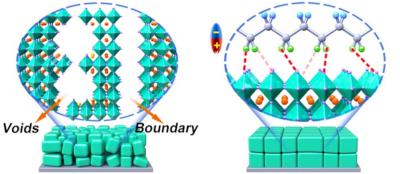Researchers from Helmholtz-Zentrum Berlin (HZB), Chinese Academy of Sciences (CAS), Swansea University, University of Stuttgart, Henan University, University of Naples Federico II, Queen Mary University of London and Soochow University have investigated a chemical variation that significantly improves the stability of the perovskite thin film in different solar cell architectures, among them the p-i-n architecture.
Daily temperature variations induce phase transitions and lattice strains in halide perovskites, challenging their stability in solar cells. The international team in this work set out to address this issue and improve the stability of PSCs in the face of these changes.
"Sunlight can heat up the inside of a PV cell to 80 Celsius; in the dark, the cell then cools down immediately to the outside temperature. This triggers large mechanical stresses in the thin layer of perovskite microcrystals, creating defects and even local phase transitions, so that the thin film loses its quality," explains Prof. Antonio Abate, who heads a large group at HZB.
The team stabilized the perovskite black phase and improved solar cell performance using the ordered dipolar structure of β-poly(1,1-difluoroethylene) to control perovskite film crystallization and energy alignment. The researchers demonstrated p-i-n perovskite solar cells with a record power conversion efficiency of 24.6% over 18 square millimeters and 23.1% over 1 square centimeter, which retained 96 and 88% of the efficiency after 1000 hours of 1-sun maximum power point tracking at 25° and 75°C, respectively. Devices under rapid thermal cycling between −60° and +80°C showed no sign of fatigue, demonstrating the impact of the ordered dipolar structure on the operational stability of perovskite solar cells.
"We optimized the device structure and process parameters, building upon previous results, and finally could achieve a decisive improvement with b-poly(1,1-difluoroethylene) or b-pV2F for short," says Guixiang Li, who is doing his PhD supervised by HZB's Prof. Abate. b-pV2F molecules resemble a zigzag chain occupied by alternating dipoles. "This polymer seems to wrap around the individual perovskite microcrystals in the thin film like a soft shell, creating a kind of cushion against thermomechanical stress," Abate explains.
The team said that scanning electron microscope images show that in the cells with b-pV2F, the tiny granules nestle a little closer. "In addition, the dipole chain of b-pV2F improves the transport of charge carriers and thus increases the efficiency of the cell," says Abate. Indeed they produced cells on a laboratory scale with efficiencies of up to 24.6%, which is a record for the p-i-n architecture.
The newly produced solar cells were subjected over a hundred cycles between +80 Celsius and -60 Celsius and 1000 hours of continuous 1-sun equivalent illumination. That corresponds to about one year of outdoor use. "Even under these extreme stresses, they still achieved 96 % efficiency in the end," Abate emphasizes. That is already in the right order of magnitude. If it is now feasible to reduce the losses a little further, perovskite solar modules could still produce most of their original output after 20 years - this goal is now coming within reach.




